One of the most famous fruits in the world is Papaya, which is renowned for its high nutritional and medicinal value. Fruits of this crop are produced in less than a year of planting, and the crops are produced in large quantities per unit area compared to other fruit crops. The Papaya plant is produced more or less commercially throughout the foothills and plain valleys of the country’s northeastern states. Let’s check out high-yield hybrid Papaya varieties in India below.
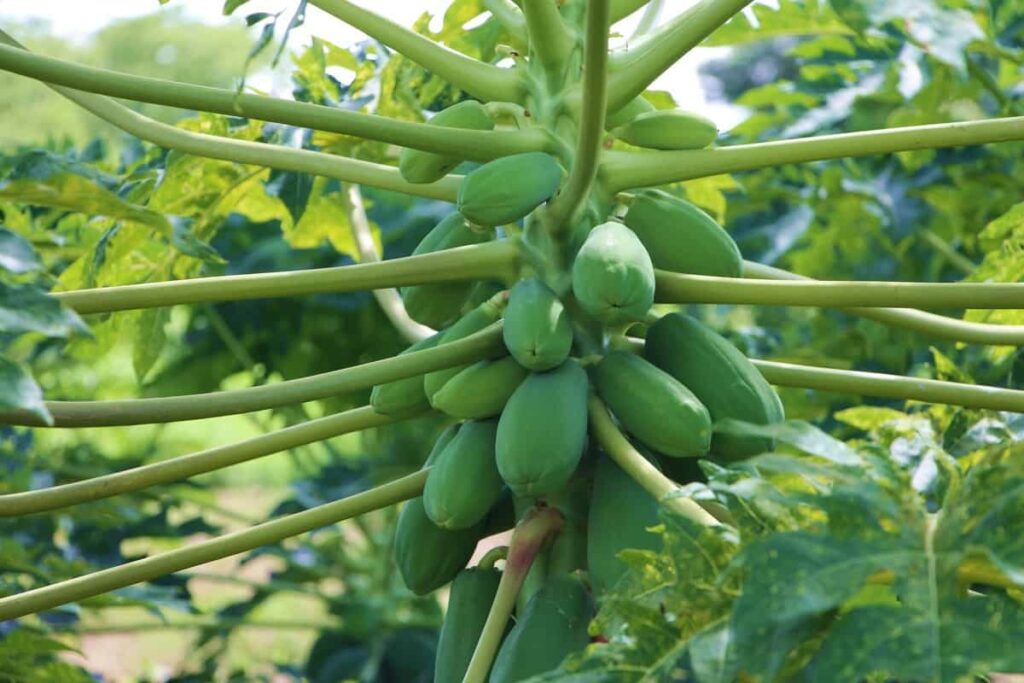
It has been estimated that the total Papaya production worldwide is about 6 million tons a year, which is astonishing. With an annual production of 3 million tons of Papaya, India is the world’s largest producer, accounting for almost 50% of the world’s total Papaya production. It is important to note that the Papaya season varies from country to country. Papayas are available in India from August to November. However, most of the states in India have a Papaya season throughout the year, which means they have Papaya season all year round.
This crop is considered one of the most important in this region. The most area under this crop is found in Mizoram, which Tripura and Manipur follow among the hill states. Among the states that contribute the most to food production, Manipur contributes the most, followed by Tripura and Mizoram. It was in the 16th century that Papaya was introduced to India, a native crop of Mexico. India has become a major producer of this fruit, making it the fifth most important fruit in terms of its commercial value.
Climatic conditions for Papaya farming
Generally speaking, Papayas are tropical plants. In addition, it also grows well in subtropical regions of the world. It is ideal for cultivating Papaya in the foothills of mountains, where the winters are mild. However, as a result of low temperatures and frost, it is not possible to cultivate it at higher altitudes. In winter, the fruits are more likely to be of poor quality because they mature slowly due to excessively cold nights.
It is possible to grow it from sea level to an altitude of 1000 meters, but there is a gradual reduction in the size and quality of the fruit above 600 meters. This plant can be grown in a temperature range between 25°C and 35°C due to its ability to grow in subtropical and tropical climates. If you are living in an area with 1500 mm to 2000 mm of evenly distributed annual rainfall, this crop can be easily grown as rainfed.
There may be a change in yield from an irrigated crop to an agronomically improved crop, but this may be because a winter drought restricts their development. In low temperatures, fruits lose their sweetness due to high humidity. Therefore, during the period of ripening, it is necessary to have a warm and dry climate. Being a tender and shallow-rooted plant, it cannot stand up to strong winds as it is very sensitive to them.
In case you missed it: High Yield Hybrid Mango Varieties in India: State Wise Growing Guide
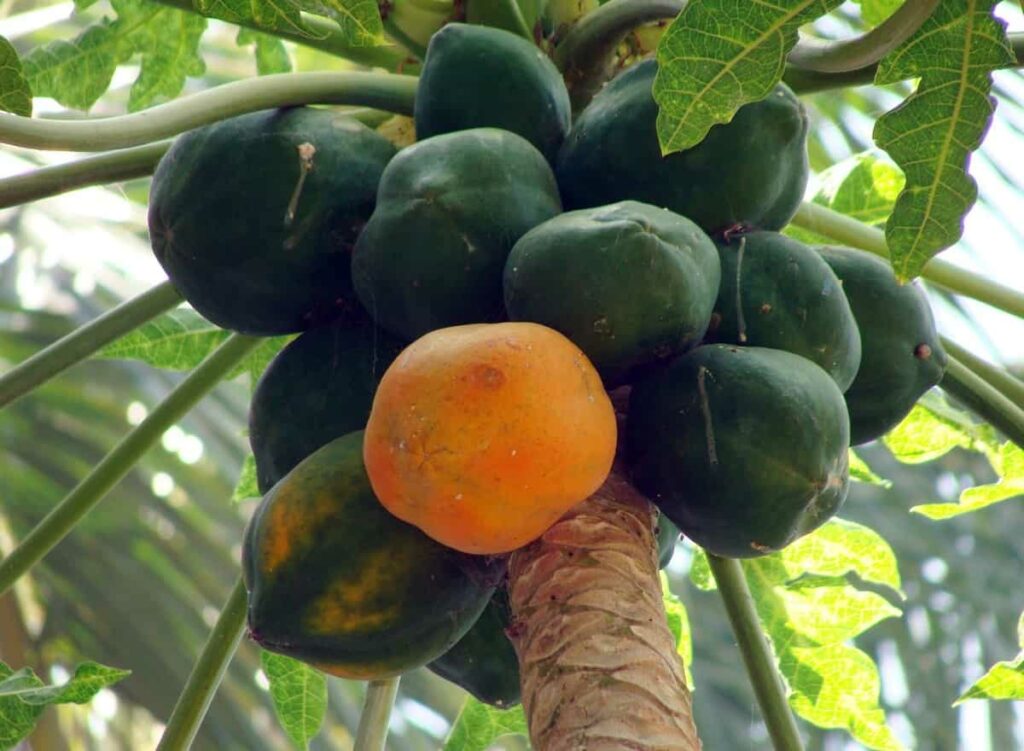
High-yield hybrid Papaya varieties in India
There have been several varieties of Papaya developed in India for cultivation. The varieties of these plants can be classified into two broad categories according to their characteristics:
- Dioecious– produce separate male and female plants
- Gynodioecious– produces female & hermaphrodite plants
Arka Prabhath
It results from a cross between Surya x Tainung-1 and Local Dwarf. Known as a gynodioecious plant, it is semi-vigorous, and the plants begin to bear fruit at a low height, about 60-70 cm when they are about one year old. Because the variety is gynodioecious, seed production is easy, as each flower has both male and female pollination parts, which ensures that the plants are true to type. This fruit has a firm pulp, and its color is a deep shade of pink. The fruit weight is estimated to be between 900 and 1200 grams on average. The yield per plant is between 90 and 100 kilograms per plant. The keeping quality is good.
Arka Surya
It is the offspring of Sunrise Solo and Pink Flesh Sweet, a hybrid. It was selected from the F14 generation of the line. As a result, seeds can be produced by bagging hermaphrodite flowers or crossing female flowers with hermaphrodite flowers to produce them. In addition to being gynodioecious, the plant does not have any male pollination parts. As for the shape of the fruits, they are similar to those of Sunrise Solo, and the plants are shorter than Sunrise Solo.
Fruits have a medium size, weighing 600 to 800 grams, with a small cavity in the center of the fruit. It has a pulp of about 3 to 3.5 cm in thickness, is reddish, and is sweet. It has smooth, uniformly yellow skin that turns uniformly yellow as it ripens. Keeping quality of fruits is good. Approximately 55 to 65 kilos of fruits are produced per plant; for an acre, this amount is between 60 and 65 tons.
CO.8
It is a dioecious variety of red pulp developed by selective hybridization of CO.2 (yellow pulped) with red anthered male followed by intermating and repeated selection. Fruits are suitable for desserts, pulping, processing (RTS, jam, tutti-fruity), and papain production. Fruits are big and oblong, weighing 1.5 to 2.0 kg on average, with a TSS of 13.5% and a prominent apex. At a spacing of 1.8 x 1.8 m, the tree can be economically maintained for 20 to 22 months with a potential yield of 93 tons per acre.
CO.7
It is a gynodioecious hybrid developed through multiple crosses and purified for over four years. This variety was developed by the Tamil Nadu Agricultural University and is a cross between Pusa Delicious, CO3, Coorg Honey Dew, and CP 85. The fruits are oblong, weigh about 1.15 kg, and have a small cavity and red pulp. The tree yields about 98 fruits per tree and about 137 tons per acre over a 28-month harvest period.
In case you missed it: High Yield Hybrid Paddy/Rice Varieties in India: For Rabi and Kharif Seasons

Red Lady
In 2013, this hybrid variety was released. The plants grow vigorously and produce fruit on their own. Upon reaching a height of 238 cm, the plants begin bearing fruit at 86 cm. Fruits are medium in size, oblong to an oval shape, and have reddish-orange color flesh with excellent taste and flavor. The plant produces an average yield of 50 kg after ten months of maturity. In addition to being resistant to pests and diseases, this variety is drought tolerant.
CO.4
From the cross of CO1 x Washington, Tamil Nadu Agricultural University released this dioecious variety with purple coloration throughout the plant. The plant has a purple color. There is a yellow pulp and a medium cavity in the fruit, which is firm and medium-sized, weighing between 1.3 and 1.5 kg. It takes this variety of Papaya trees two years to produce 80 fruits per plant.
CO.3
Andhra Pradesh is the most popular region for this variety. The Tamil Nadu Agricultural University, Coimbatore, bred the hybrid from the CO2 and Sunrise Solo cross. In addition to being pyriform and smooth, these fruits weigh about 800 grams, have a medium cavity, a red pulp, and a good keeping quality. Approximately 90 to 120 fruits are produced per plant.
Pusa Majesty
IARI Regional Research Station, Pusa, in Bihar, developed this gynodioecious line. Within 245 days of planting, it bears fruits at a height of 48 cm. A typical fruit weighs between 1 and 1.5 kilograms. The fruit has a 17 x 9 cm cavity and 3.5 cm thick orange pulp. In addition to having a long shelf life, it is suitable for long-distance transportation. It yields about 38 kg of fruits per plant.
Pusa Giant
Siblings of the variety Ranchi were used to create this dioecious selection. In addition to being extremely vigorous, plants bear their first fruit at the height of one meter and can withstand storms and windy conditions. It weighs 2 to 3 kg with a yellow, moderately firm, 5 cm thick pulp and an 18 x 10 cm cavity. Approximately 40 kilograms of fruit are produced per plant.
Pusa Delicious
It is a gynodioecious, high-yielding variety developed by sib-mating the variety Ranchi and these plants are medium-sized, with first fruiting at 80 cm height 253 days after planting. Each fruit weighs between 1 kg and 2 kg and has a distinctive flavor and mild keeping quality; its pulp is deep orange, 4 cm thick, and has a 14 × 8 cm seed cavity. Approximately 41 kilograms of fruits are produced per plant.
Pusa Dwarf
Developed through sib-mating from the variety Ranchi, it is a dioecious selection. They grow to a height of 40 cm, making them suitable for high-density plantings and kitchen gardens. Fruit weighs about 0.5 to 1 kilogram, is oval to round, and is medium size. Its pulp is yellow, moderately firm, and 3.5 cm thick, and its cavity is 12 x 8 cm. A plant of this Papaya variety yields about 40 kg of fruit.
Pusa Nanha
A dioecious dwarf mutant with a height of 106 cm, bearing fruit at a 30 cm height, suited for pot cultivation and high-density planting. A low cavity and thin, yellow pulp define the fruit, usually round to ovate. Each plant yields about 10.1 kg of fruits and 26 tons per acre.
In case you missed it: High Yield Hybrid Cotton Varieties in India – For Rabi, and Kaharif Seasons
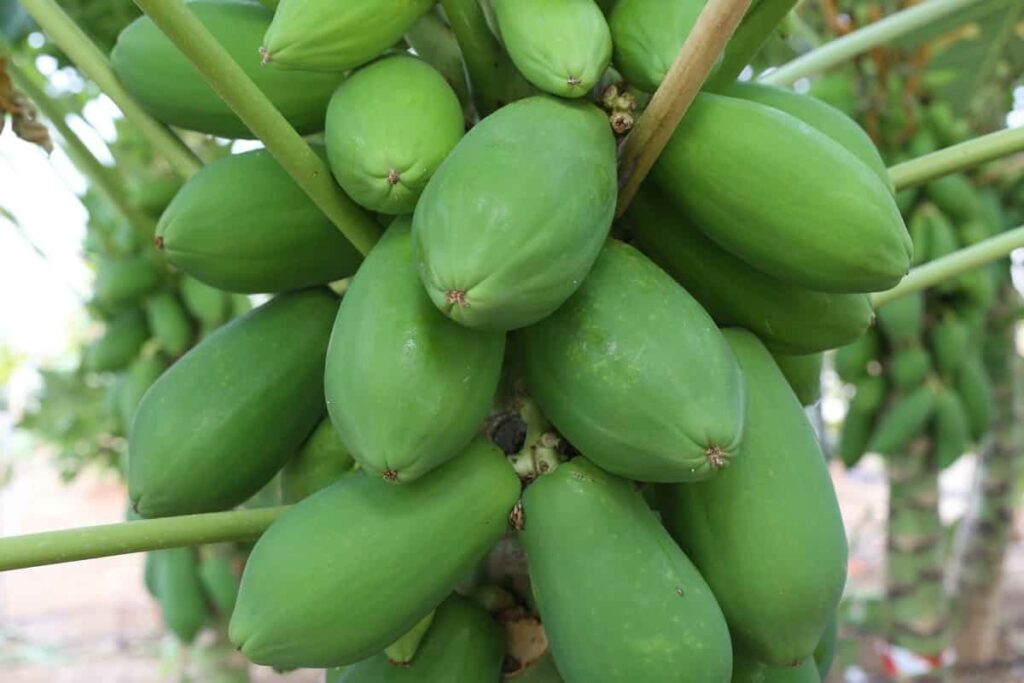
Coorg Honeydew
Known as Madhu Bindu, it is a selection from Honey Dew. The plant is gynodioecious and semidwarf. On average, fruits weigh between 1.5 and 2.0 kg, and their skin is dark in color with ridges on their surface. Hermaphrodite trees produce elongated and oval fruits. When it ripens, the pulp turns yellow and melts. Keeping quality is poor. Approximately 70 kg of fruit is produced per tree. When Coorg Honey Dew Papaya is cultivated, papain and fruit yields have increased by 25% to 30%.
Washington
Generally, it is used for table purposes. Fruits are round to ovate, medium-large in size, and contain few seeds. The skin turns bright yellow when ripe. Fruit weighs between 1.5 and 2 kilograms on average. This Papaya variety has separate male and female plants. Approximately 60 kg of fruits is produced per plant.
Barwani Red
Dioecious Barwani Red is similar to Washington but dwarf, devoid of purple color, and yields about 40 kg of fruit per plant. With a large cavity and good keeping quality, these fruits weigh between 0.5 and 2 kg.
Ranchi
It is one of the best Papayas in India and comes from the states of Bihar and Jharkhand. This type is also a popular cultivar in some south Indian states. The fruits come with a yellow color pulp that tastes sweet. A single tree can also bear many fruits in one season.
Best planting time for Papaya farming and seasons in India
August to November is the peak Papaya season in India. During the monsoon season and the spring, Papaya plants are planted. The crop cannot be planted during the winter because of the risk of frost damage. The Papaya plant has a limited economic life of 3 to 4 years, and its yield varies greatly based on the variety, soil, climate, and orchid management.
An acre of Papaya orchid can yield between 30 and 45 tons of fruit per season, depending on spacing and cultural methods. In Karnataka, Andhra Pradesh, and Kerala, Papayas are cultivated yearly. A Papaya season exists throughout the year in even the northern states. In Maharashtra, West Bengal, Gujarat, and Arunachal Pradesh, the Papaya season last all year.
| Season | Month |
| Spring | February-March |
| Monsoon | June-July |
| Autumn | October-November |
In case you missed it: High Yield Hybrid Chilli Varieties in India: For Rabi, Kharif, Winter, Summer, and Rainy Seasons
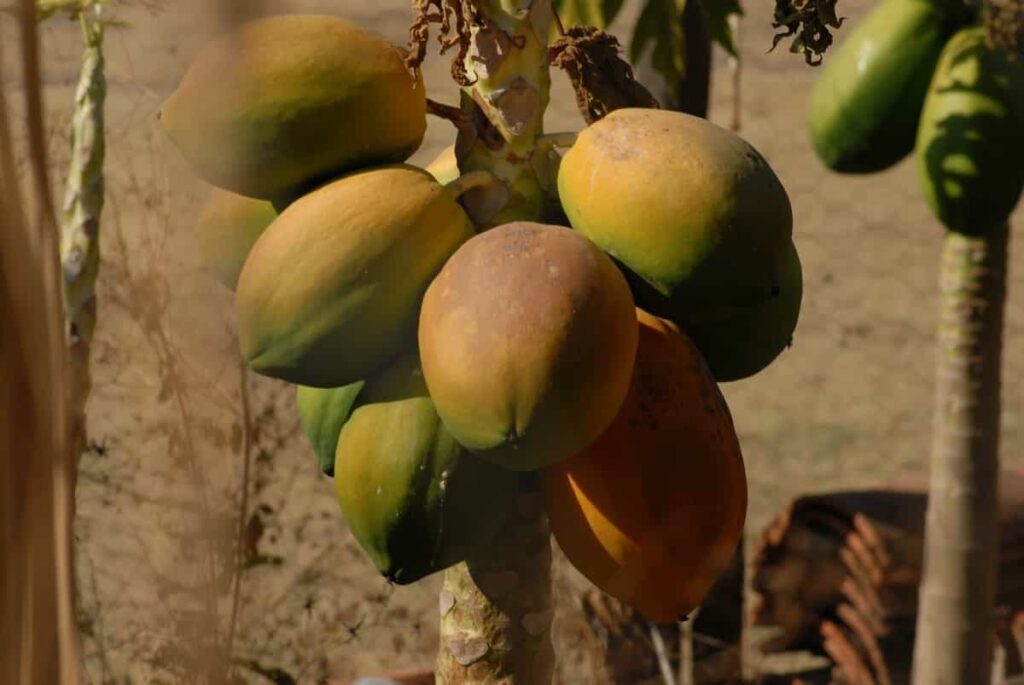
Papaya varieties cultivation in various states
| States | Papaya varieties grown |
| Karnataka and Kerala | Coorg Honey Dew, Sunrise Solo, CO.3, CO.4, Arka Surya, Arka Prabhath, and Taiwanese lines. |
| Andhra Pradesh | Taiwanese lines, Arka Surya and Arka Prabhath |
| Tamilnadu | CO.2, CO.5, CO.6, CO.7, CO.8, Arka Surya, Arka Prabhath, Coorg Honey Dew, and Taiwanese lines. |
| Uttarpradesh | Coorg Honey Dew, Pusa Dwarf, Pusa Delicious, CO.1, CO.5, and Barwani Red. |
| Orissa | Coorg Honey Dew, Surya, Washington, Ranchi, Pusa Dwarf, and Pusa Delicious. |
| Bihar | Pusa Dwarf, Pusa Majesty, Pusa Nanha, Pusa Giant, Pusa Delicious, and Ranchi |
| Maharashtra | Taiwanese lines |
Tips to boost Papaya yield
The right way of watering
There are large leaves on Papayas that have a soft texture. This is because a lot of water evaporates through them in warmer climates. Therefore, it is important to supply sufficient water to your plants, especially during the initial growth stages. In contrast, overwatering can cause root rot. This issue often arises during colder seasons when evaporation levels are lower.
Additionally, Papayas are susceptible to waterlogging due to heavy rains in non-porous soils. Therefore, choosing a slightly sloped field is better than a perfectly level one. To help your plants grow to their full potential, make sure you water them appropriately based on the soil and climate conditions in your area.
Wind protection
Papayas are susceptible to heavy winds and often break when under duress. The reason is that they are tender and shallow-rooted. If you intend to maintain a Papaya orchard, windbreakers are essential. Identify the direction from which wind flows into your field and plant windbreak trees to protect it. In the long run, it also prevents soil erosion damage.
Manure and fertilizers
For Papayas, fertilizer and manure are needed in large quantities. It is necessary to increase the application size as the plant matures. In promoting growth and increasing yields, nitrogen, phosphorus, and potassium play a big role. Every year, a minimum of 20 to 25 kg of farm manure should be given to each plant. Optimal irrigation should be maintained while providing 400 g of nitrogen and potassium and 250 g of phosphorus in six split applications.
Combating Pests and Diseases
Growing Papayas requires taking a preventive stance because Papayas are vulnerable to a wide variety of pests and diseases. It would be best if you were prepared to handle conditions ranging from black rot to internal yellowing. With these actionable tips, you can lengthen your plants’ life spans while achieving better yields.
In case you missed it: 22 Agricultural Apps for Smart Farming Solutions: Help with Farm Management, Soil, and Crop Yield
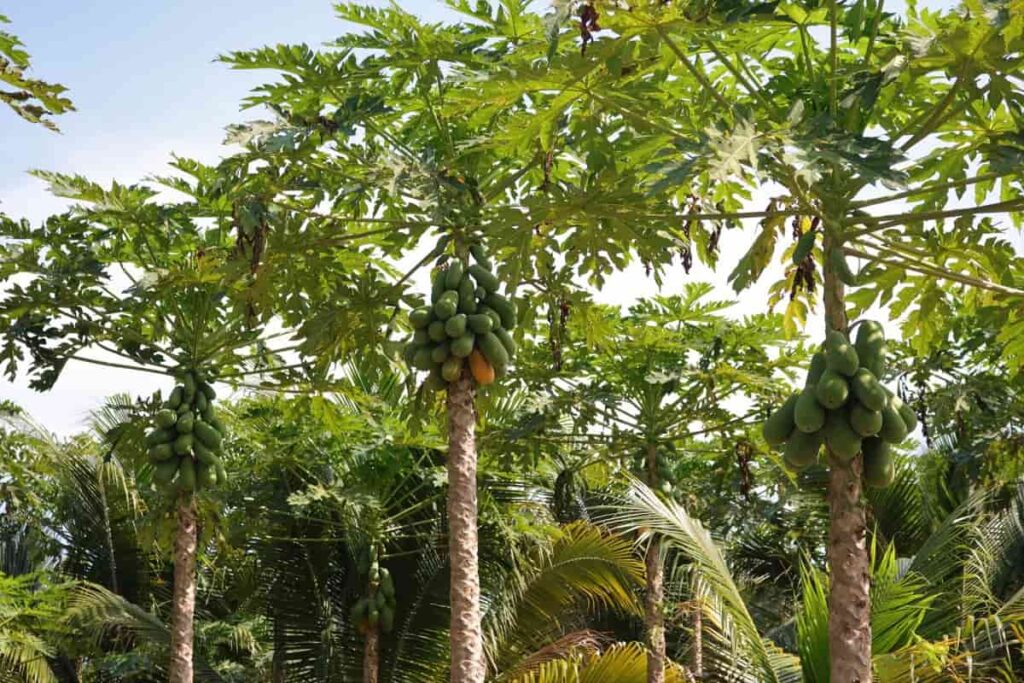
Harvesting Papaya
It is time to harvest the fruits when they are fully grown and have a yellow tint at the apex. The latex can also determine harvesting time. Once the latex turns watery instead of milky, the fruits must be harvested. Some Papaya varieties do not turn yellow when they ripen. Some turn yellow when fully ripe, and some remain green when fully ripe.
It lasts for a maximum of four years in the economic world. Despite this, farmers do not live beyond 2 to 3 years because their production decreases from the 3rd year onward. However, it can be greatly increased when Papaya production is managed well and cared for on time.
Conclusion
By cultivating the above-mentioned hybrid varieties, you will have chances to get higher yields compared to traditional cultivars. Additionally, these varieties are tolerant to diseases up to some extent and reduce the crop period so you can have the plants produce early.
- Budget Friendly Sheep Shed Ideas: Cheap and Low-Cost Tips
- How Much Do Cattle Farmers Make: Revenue Streams in Cattle Farming
- Management Pests and Diseases in Your Cotton Field
- Sheep Farming Business Plan for Beginners
- Aquaponic Farming at Home: A Step-By-Step Guide
- Profitable Village Farming Business Ideas in 2024
- High-Yield Aquaculture: Fast-Growing Fish for Farming
- Effective Fish Pond Construction Techniques for Beginners
- Irrigation and Water Management in Pineapple Farming
- Blossom to Harvest: Mastering Flowering and Pollination in Papaya Farming
- Pig Fattening Essentials: From Selection to Sale for Beginners
- Raising Wagyu Cattle: A Complete Guide for Premium Beef Production
- Soil Types and Their Water Holding Capacity
- Optimizing Irrigation Schedules for Coconut Groves for Enhanced Yield
- Espresso Your Garden: Coffee Grounds for Healthier Acid-Loving Plants
- The Best Soil Mix for Snake Plants: How to Mix Your Own Snake Plant Soil
- Green Thumb Success: Expert Tips for Cultivating Greenhouse Beans All Year Round
- Bloom All Year Round: The Ultimate Guide to Indoor Hyacinth Care
- Eco-Friendly Gardening: How to Make Liquid Fertilizer from Kitchen Waste
- Ultimate Guide to Grow Anise in Pots: Explore Seed Propagation to Harvesting
- Guide to Raising Chester White Pigs: Discover Breed Facts to Growth Management
- Mastering the Elegance: The Ultimate Guide to Weeping Cherry Tree Care, Planting, and Maintenance
- Ultimate Guide to Planting Garlic in Grow Bags: Growing Strategies for Beginners
- How to Fix Spider Plant Leaf-Related Problems: Natural and Organic Remedies
- 10 Reasons Why Your Tulsi Plant is Shedding Leaves: Home Remedies and Solutions
- Optimizing Growth and Yield: The Advantages of Palm Bunch Ash Fertilizer
- Utilizing Neem Oil Extract as a Natural Pesticide for Hydrangea
- From Soil to Harvest: Various Ways in Which Farmers Can Use AI Tools
- Steps to Encourage and Induce Citrus Flowers: A Comprehensive Guide
- How to Fix Snake Plant Leaf-Related Issues: Natural and Organic Remedies
- Transform Your Garden into a Fragrant Oasis with Raat Ki Rani (Night Blooming Jasmine)
- Discover the Ideal Chicken Breeds for Philippine Farms
- How to Create a Poultry Egg Farm Business Plan for Profits
- Grow Lemon Cucumbers Like a Pro: Insider Techniques for Bountiful Yields
- Ultimate Guide to Caring for Your Pink Princess Philodendron: Tips for Thriving Variegation
- Areca Nut Profit Per Acre: Calculating Yield and Cost of Cultivation
